Is the keyword dead?
This is a question we’ve been discussing for months. The answer? Absolutely not. As organic clicks steadily decline due to the addition of SERP features like Featured Snippets and People Also Ask, it has never been more important to make keyword and topic research the foundation of your content strategy in 2020.
How do you do keyword research the right way?
In this article, we review why generating qualified organic traffic is harder to generate then it used to be. Then, we outline the steps you should be taking to develop a targeted keyword strategy that draws more qualified traffic to your site.
How to do keyword research for content marketing
Organic clicks are declining.
With the emergence of featured snippets and other SERP attributes—in addition to paid advertising space, we are seeing the top organic search results get pushed further and further down the search results page.
And that’s not all: if searchers find their answer directly from the search result page, why even bother clicking through to the supporting content?
For example, let's consider the search phrase “What time is it in Germany”. In 2015, you would have clicked through to the first result listed—timeanddate.com. Today, Google generates the time right on the results page (as seen below).
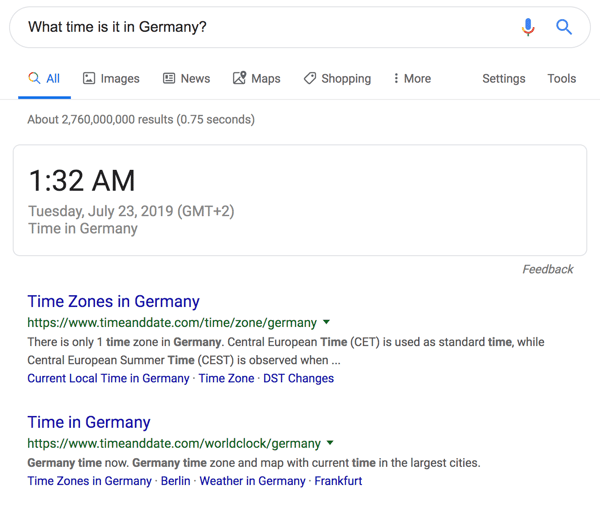
With the query fully answered in this SERP feature, there really is no need to click through to any website that would provide the same information.
MozCast is updated in real-time to help you see just how many of these features are appearing in search results. Here’s what that landscape looks like as of today:
|
SERP FEATURE
|
% OF RESULTS
|
|
Related Questions
|
86%
|
|
AdWords (Top)
|
42%
|
|
Reviews (Stars)
|
39.5%
|
|
Local Packs
|
39%
|
|
Knowledge Panels
|
38.3%
|
|
Images
|
22.4%
|
|
Site-Links
|
21%
|
|
Videos
|
19.7%
|
|
Featured Snippets
|
17.9%
|
|
AdWords (Bottom)
|
16.4%
|
|
Top Stories
|
12.4%
|
|
Shopping (Paid)
|
12.3%
|
|
Local Panels
|
7.9
|
|
Tweets
|
6.6%
|
|
Knowledge Cards
|
3.7%
|
What does the increase of SERP features mean for your organic search ranking?
With more and more of the SERP being filled with features like videos, tweets, and knowledge panels, the need to click through to get answers is eliminated in many cases. In fact, we've seen organic traffic drop steadily over the past 12 months with respect to several keywords for which our own agency organically ranks in the number one position.
In fact, our most popular blog post—9 Tips That Get More People to Subscribe to Your Email, which has always performed well for us—has seen a drop of over 1,000 monthly views since January of 2019. All despite that the page still ranks in the #1 organic spot for several target keywords related to email marketing!
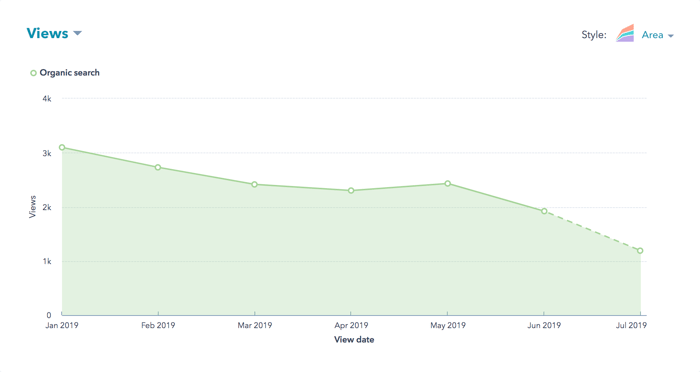
What's particularly strange is that other metrics like bounce rate, time on page, submissions, and attribution to new contacts have not been impacted in the same way. Surprisingly, the average amount of time spent on the page has gone up from three minutes to nearly five...
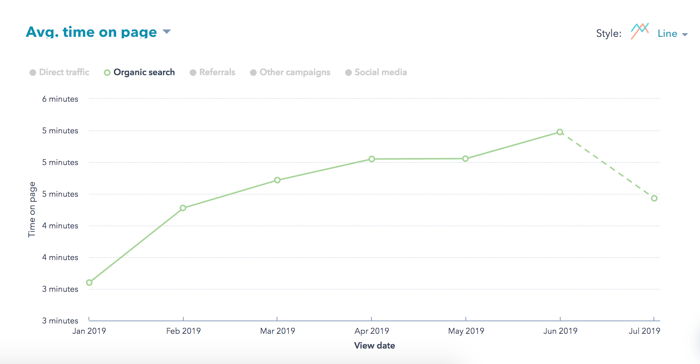
This steady drop in traffic is something that had us puzzled. If the same amount of people are still performing searches on this topic every month, and we own the first organic result, why is traffic to the post declining?
Well, here's a possible explanation. We may be able to attribute this drop in traffic to the SERP feature that has been being populated using information from our page.

It’s possible that those searchers that are just looking for quick inspiration may simply feel satisfied with the insights in the list provided directly on the SERP.
In fact, we’ve seen traffic drop for core content pieces for many of our clients, despite the organic rank remaining the same. In almost every content example we researched, there was a SERP feature that summarized the answer to the query in the SERP.
Here’s what OrbitMedia has to say about this trend:
61% of mobile searches lead to SERPs that don’t get clicked (up 6% over the last 2.5 years) and a third of desktop searches are no-click (up 3%). There are 5.6 billion Google searches per day, which means roughly 250 million fewer visits to websites each day.
So this is the mega-trend in SEO: more features on search results pages and therefore a lower click-through rate to websites.
Moreover, since Q1 of 2016 there has been a decline of nearly 20% of clicks. In other words, that’s ⅕ less click opportunity for Q1 of 2019, only a short three years later.
But there is a light at the end of the tunnel! According to Jumpshot and SparkToro, 41.45% of clicks still go to organic non-google sites, which is nearly 12 times higher than clicks to paid search ads—at just 3.58%
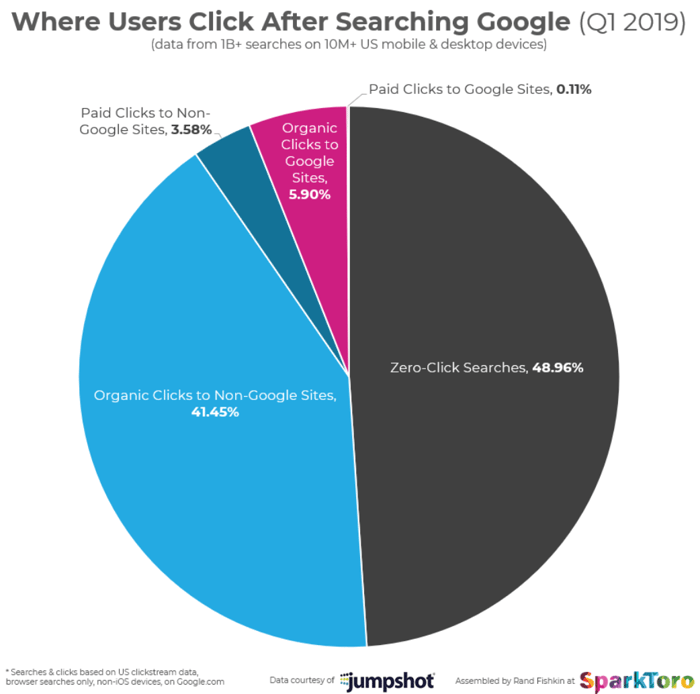
But that big gray block of 48.96% of zero-click searches can be reasonably attributed to the increase of on-page SERP features. That’s an enormous amount of lost opportunity for sites wanting to prioritize attracting organic traffic.
Should we give up on organic SEO?
This is clearly a trend that will continue. As Google tries to serve visitors answers with fewer clicks and keep visitors engaged with it’s own results page, it can feel a bit unfair. Why bother trying to rank organically when clicks are dropping by 20% or more? How can small and mid-sized businesses create a successful content strategy when half the click opportunities are taken by mega-sites and Google is serving up SERPs for the rest?
For the pep talk we all needed, I invite you to watch this video about this traffic trend by Rand Fishkin. Listen to him discuss the importance of SEO for modern marketers at 21:30.
TLDW; The two conflicting truths for modern marketers... #1: It’s never been harder to earn organic traffic from the web’s major players. And #2: It’s never been more important to make your website (and email list) the center of your campaigns.
The good news is: you can use strategic keyword research to increase your chances of searchers clicking through to your content instead of a ranking competitor's.
How to Do Keyword Research for Content Marketing
We can’t fight Google, and we also can’t afford to not follow these trends. Why? Because if our competitors rank better, they’re still going to get more qualified traffic. So here are the steps you can take to dramatically improve your chances of ranking.
1. Identify your core content topics.
It’s not enough to simply write about a topic that we think is important to our website visitors. First, take a step back and think about the bigger picture.
What is it that you want your company to be known for? What are your organization's areas of expertise? Those topics are probably going to be heavy-hitting generalized terms. For B2B companies from a variety of industries, this might look like:
- Automated Storage and Retrieval Systems
- Digital Transformation
- Outsourced Marketing
- Call Center Quality Assurance
Start by trying to identify your “one thing”. What is it that you help people do? That’s probably going to be your primary topic. And yes, it’s possible to have more than one! For example, we rank for outsourced marketing services but we also want to be known for HubSpot consulting, lead generation, and website design, to name a few.
These topics would ideally fit into a larger topic cluster and pillar content strategy. Here’s a post that discusses this in more detail.
This first step is critical because every piece of content you create for your website, blog, or social channels should be a thoughtful brick that reinforces the structure of your topic. Becoming an authority on your topics through highly-targeted supporting content is one of the best ways to boost your organic traffic.
2. Break your topic down into supporting terms.
Once you’ve determined your topic, it’s time to break that down into its core pieces and variations. Think of your supporting terms as the foundational beams that support your topic. Because chances are, there is a ton of organic competition surrounding your core topic.
Unless you’re a mega-site, your chances of ranking for your core topic term is slim. Instead, you want to find low-hanging fruit variations to attract qualified traffic.
We discuss how to identify low-hanging fruit keyword terms later in this post.
To give you a concrete example, let’s pretend you work at a veterinary clinic that focuses on dog health. Here are some examples of topic cluster terms:
CORE TOPIC (Pillar):
SUPPORTING TERMS (The nitty-gritty of what you sell/do):
- DIET
- NUTRITION
- HEALTH
- CHECK UPS
- VACCINES
- TEETH CLEANING
- WEIGHT LOSS
- PHYSICAL THERAPY
- ALTERNATIVE MEDICINE
- NEW PUPPY SHOTS
- SPAY/NEUTER
You get the idea. Treat this list as a total brain dump of related terms.
PRO TIP: Need inspiration? Interview your customers. Talk to them about their pain points. Ask them about the time before your product or service came into the picture. Find out how their life or job has changed since purchasing. And frankly, ask them about the words and phrases they would type into Google to find you. You can also ask your sales and service teams for insight. They talk to potential buyers every day. Don’t just assume you know what terms you want to rank for.
3. Research variations using suggested terms tools.
Now, what we like to do is give each of these supporting terms their own tab in a google sheet. Here is where we are going to house all our research categorized by supporting term.
Here are some great keyword suggestion tools:
And don’t discount the power of using Google itself for suggested terms. This is a great approach if you’re restricted for time or budget.
Start by typing your keyword into Google. What suggestions appear in the drop-down?
Here’s what is suggested when we type “dog diet” into Google’s search bar:
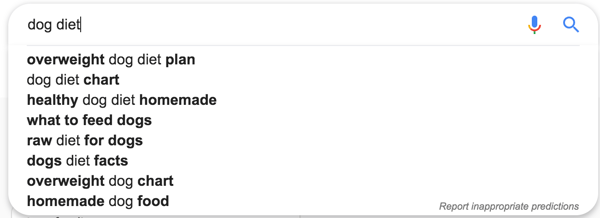
And for even more variations, complete a search and scroll to the bottom of the SERP to see suggested or related terms to try:

One of our favorite resources is Answer the Public—for its user-friendly export features and visualization tools. This tool is ideal for people who complete keyword research every once in a while. While AtP is easy to use and offers a lot of free features, it does not offer as much insight into search metrics and competition as some of the other tools we've tried.
Here are some of the results we generated by entering “dog diet” into Answer the Public’s suggestion tool:
- what is a balanced dog diet
- what is the mountain dog diet
- what is prescription diet dog food
- what is a bland dog diet
- what is the ideal dog diet
- what is a hypoallergenic dog diet
- what is a natural dog diet

This simple term generated more than 467 suggested keyword variations. We highly recommend exporting all these variations and adding them to a spreadsheet—which brings us to our next recommended step...
Another great tool we use daily is SEMrush's Keyword Magic tool. This tool is ideal for those whose primary role is to develop and execute content strategy. Why? Because the Keyword Magic tool populates suggested terms - just like Answer the Public - and also provides you with:
- Monthly search volume
- Search trends over time
- Keyword difficulty metrics (how hard is it to rank for this term?)
- The CPC (cost per click)
- The number of SERP features appearing for that term
- And the number of search results
Here are the results for Dog Diet from SEMRush. This tool generated over 18,000 keyword variations.
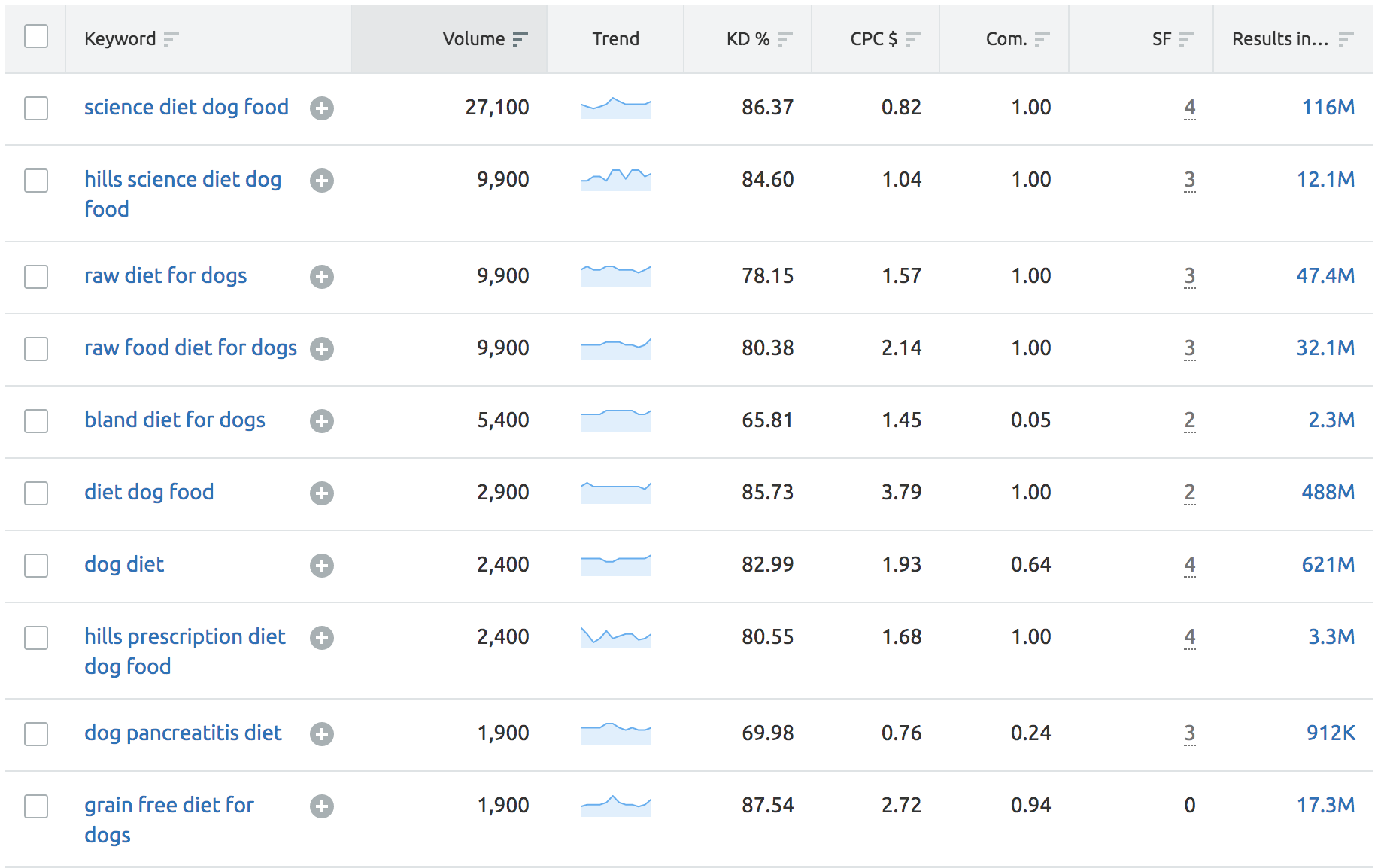
4. Add all of your suggested variations to a spreadsheet.
As we’ve seen in our example, a simple term can generate anywhere from 20 to thousands of suggested terms. And while the majority of the suggested terms would each make a nice blog post, we need to first determine which search terms have the most search volume.
PRO TIP: You may not want to ignore low-volume search terms. Many SEO experts believe that qualified traffic can still be generated from targeting long-tail keywords with little to no monthly search volume. Even though these terms don’t generate enough traffic to register 10+ searches per month, if you rank for them, you can still draw highly-qualified traffic to your site over time. This is especially true if the long-tail keyword you choose is particularly relevant to your business model or solution.
That’s where our spreadsheet comes in, acting as an organizational guide to house our keyword variations.
We like to organize our spreadsheets by topic, giving each subtopic its own tab in the spreadsheet. This enables you to reference the spreadsheet in the future when you’re writing or brainstorming content about those topics.
Here’s what that looks like in action:

(Also, can we just take a moment to appreciate the suggested term: can dogs have diet pepsi? No. The answer is no.)
5. Research even more variations using suggested terms.
Sometimes your research will inspire a completely different content direction. For example, a lot of keywords in our research about dog diets generated variations about how to best care for dogs that have food allergies. Due to the amount of recommended terms for this topic, we can assume this is a great content channel for this topic.
You really can’t have too much data, so use your spreadsheet as a complete content dump. Then, let the data show you what your priorities should be.
6. Get monthly search volume and competition metrics.
Paid tools like Moz Keyword Explorer and SEMrush can help you generate monthly search volume and competitive data quickly and easily.
If you don't have access to some of these specialized paid tools, have no fear. Google’s Keyword Planner is still considered a go-to for marketers that already have access to Google Ads Manager.
Whichever tool you use, you’ll want to enter all your keyword variations collected from your sheet to your search volume generator.
If you’re using Google’s Keyword Planner, first select “Get search volume and forecasts”

Then, paste the keyword variations from your spreadsheet into the tool. Once the report generates, select export and then choose to export “Plan historical metrics (.csv)”
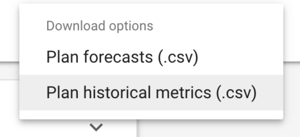
This will generate a report that shows you the search volume and competitive metrics. You can organize the spreadsheet by terms that have the highest search volume to get an idea of what terms are generating the most traffic.
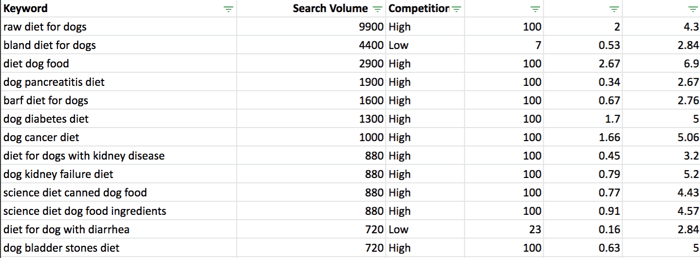
Once you have search volume data for all your variations sorted by highest search volume, you’re ready to start identifying content opportunities.
7. Use your data to identify low-hanging fruit terms.
A low-hanging fruit keyword is one that has a high search volume and a low competition rating. This is the ideal keyword to design targeted content around because there are a lot of people searching for it, but very few high-authority sites writing about it.
In our example, “bland diet for dogs” is the perfect search term because 4,400 people are searching for it, but it has a competitive rating of only 7!
PRO TIP: Don't be discouraged by a very high competitive rating. Most tools use inbound links alone to determine competitive ranking. Meaning: they assign higher competitive value for terms that have results with the most inbound links. But inbound links don't make a content piece great! If you're going after a high-value term, just make sure you do your research to write the best content for that search query.
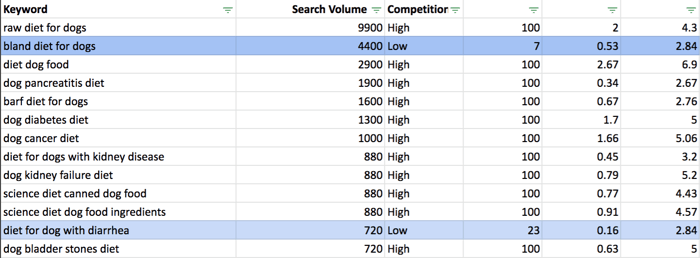
Highlighting terms that represent your low-hanging fruit is an easy way to quickly identify content opportunities as you put together your plan.
8. Type these terms into Google.
The next step is to make sure the term really is going to be relatively easy to rank for. The best way to do this is to simply type the term into Google. Then research:
- What websites are ranking for this term?
- How is that content formatted?
- Does the content that is ranking fully answer the question or address the searcher's needs?
- Is there a SERP feature for this term?
- Are there websites with high domain authority to which you could pitch a guest blog post?
Use your findings to build a targeted editorial content calendar that will allow you to hyper-target these keywords—by creating content that answers the search term better than anyone else. These terms then become part of your larger SEO strategy.
Read: How to Create an SEO Strategy Without Becoming a Content Factory
Bonus Tips: Generating more traffic to your pages...
When it comes to content optimization, here are a few suggestions for putting all your keyword research to good use. You can drive more qualified traffic to your pages by:
- Write content that targets featured snippets. If there isn’t a snippet already in existence for a particular query, try to write a new blog post or update and optimize an older post to target the SERP feature.
- Craft and test compelling content titles and meta descriptions. The meta description is what shows up beneath the title of the page when you scroll through search results (provided there is a high-quality meta description). Combined with the right headline, you're more likely to entice people to click.
- Write using language that resonates with your audience. Keep in mind the style and tone that your audience prefers when it comes to content consumption. You almost always win when you prioritize your buyer personas over the search engines.
- Drive qualified traffic to your pages through paid search campaigns. If you need a little extra boost to kick things off, paid ads can be your friend.
- Create varied content types. This might include presentations (.ppt), ungated crawl-able white papers (.pdfs), videos, infographics, case studies, reports, image galleries, and more.
If you have any questions about keyword research, SEO, or content strategy, we are all ears! Just leave a comment below or contact our team for more information. And feel free to subscribe to our blog and/or monthly newsletter for a regular serving of B2B marketing tips!

























